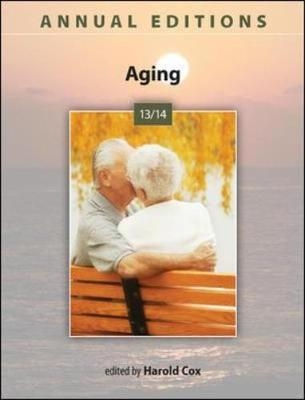
Annual Editions: Aging 13/14
McGraw-Hill Professional (Verlag)
978-0-07-813608-5 (ISBN)
- Titel ist leider vergriffen;
keine Neuauflage - Artikel merken
The Annual Editions series is designed to provide convenient, inexpensive access to a wide range of current articles from some of the most respected magazines, newspapers, and journals published today. Annual Editions are updated on a regular basis through a continuous monitoring of over 300 periodical sources. The articles selected are authored by prominent scholars, researchers, and commentators writing for a general audience. Annual Editions volumes have a number of organizational features designed to make them especially valuable for classroom use: a general introduction; an annotated table of contents; a topic guide; an annotated listing of supporting World Wide Web sites; Learning Outcomes and a brief overview at the beginning of each unit; and a Critical Thinking section at the end of each article. Each volume also offers an online Instructor's Resource Guide with testing materials. Using Annual Editions in the Classroom is a general guide that provides a number of interesting and functional ideas for using Annual Editions readers in the classroom. Visit www.mhhe.com/annualeditions for more details.
Annual Editions: Aging, 26e
Preface
Series
Correlation Guide
Topic Guide
Internet References
UNIT 1: The Phenomenon of AgingUnit Overview1. Elderly Americans, Christine L. Himes, Population Bulletin, December 2001The author points out the ever-increasing number and percentage of the U.S. population comprising persons 65 years of age and above. Furthermore, she observes that those over 65 are living longer than did previous generations. Currently, those 85 and older are the fastest-growing segment of the elderly population.2. America's Old Getting Older, Associated Press, Washington, Terre Haute Tribune-Star, November 18, 2011The article examines the increasing numbers and percentage of the population living into their 90s and older. It also presents the reasons for this increase in longevity as well as the problems confronted by the older population.3. Living Longer: Diet and Exercise, Donna Jackson Nakazawa and Susan Crandell, AARP The Magazine, September/October 2006This article points out the current findings in the areas of diet and exercise that, if followed, would increase the individual's life expectancy by a number of years.4. How to Live 100 Years, Alice Park, TimeHealth, February 22, 2010The article outlines some of the major advantages that persons who are very old have enjoyed that allowed them to live longer than most other Americans.5. Will You Live to Be 100?, Thomas Perls, MD and Margery Hutter Silver, EdD, Living to 100, 1999After completing a study of 150 centenarians, these Harvard Medical School researchers developed a quiz to help calculate one's estimated life expectancy.6. Long Live . . . Us, Mark Bennett, Terre Haute Tribune-Star, March 27, 2011The author points out how much life expectancy in the United States had increased by the year 2009 and how much difference there was in the life expectancy of men in comparison to women. The article presents reasons for the increasing life expectancy of the U.S. population as well as the reasons why women have a longer life expectancy than men.UNIT 2: The Quality of Later LifeUnit Overview7. Age-Proof Your Brain: 10 Easy Ways to Stay Sharp Forever, Beth Howard, AARP The Magazine, February/March 2012This article points out the 10 steps persons can take to direct their lives and activities to reduce any risk of developing dementia or Alzheimer's Disease.8. The U-bend of Life: Why, Beyond Middle Age, People Get Happier as They Get Older, The Economist, December 18, 2010The article on the U-bend of life points out why older people are happier than younger people once they pass through the middle years. The most unhappy people are seen as those in their 40s and 50s. After these middle years, the happiness and life satisfaction of the individual rises as their age increases. The article discusses the possible reasons why this change in outlook occurs in later life.9. Poll: Obesity Hits More Boomers in U.S., Associated Press, Washington, Terre Haute Tribune-Star, July 19, 2011The baby boomers born between 1946 and 1965 are now approaching and gradually moving into their retirement years. The current boomers are more obese than earlier generations of older persons.10. The Myths of Living Longer, Howard S. Friedman, PhD and Leslie R. Martin, PhD, Parade, February 20, 2011The authors examine six popular beliefs about how to live a longer life to determine their accuracy. The article raises a number of questions about the reliability of these popular beliefs about lifestyle patterns and longevity.UNIT 3: Societal Attitudes toward Old AgeUnit Overview11. Society Fears the Aging Process, Mary Pipher, An Aging Population, 2002The author contends that young and healthy adults often avoid spending time with persons who are old because it reminds them that someday they too are going to get old and die. Moreover, she contends that the media portray negative views of the aging process, which are expressed through the use of pejorative words to describe persons who are elderly.12. We Need to Fight Age Bias, Jack Gross, AARP Bulletin, vol. 51, no. 7, September 2010When the Farm Bureau Financial Group in Iowa merged with the Kansas Farm Bureau, all claims employees were offered a buyout or a demotion. Jack Gross was 54 and demoted after 13 years of performing this job. He sued the company for age discrimination. The article discusses the results of this case as it went to a federal jury, an 8th circuit court jury, and the U.S. Supreme Court.13. Friendships, Family Relationships Get Better with Age Thanks to Forgiveness, Stereotypes, Amy Patterson Neubert, Terre Haute Tribune-Star, 20, 2010The author points out how adults who are older perceive the quality of their marriages, their friendships, and their relationships with children and siblings. Furthermore, she examined whether adults who are older were more or less confrontational in difficult interpersonal situations.14. How Old Do You Feel Inside?: The Key to Staying Healthy and Living Longer Is Deciding You're Not Old and Decrepit, Alexia Elejalde-Ruiz, Tribune Newspapers, October 12, 2011The article points out how people who are older feel internally about themselves and their capabilities, which determines a great deal about their behavior and approach to aging. The author points out the advantages to men and women over 50 who have more positive self-perceptions of aging in terms of their health and behavior.UNIT 4: Problems and Potentials of AgingUnit Overview15. Never Have a Heart Attack, Gina Kolata, AARP The Magazine, January/February 2010The author points out the risk factors that are most likely to cause a person to have a heart attack. She then outlines and discusses the six steps that an individual could take to significantly reduce the chance of ever having a heart attack.16. The Worst Place to Be If You're Sick, Katharine Greider, AARP Bulletin, March 2012The author notes the number of persons who die in the hospital each year from preventable medical mistakes. Furthermore, a report on the results of a study of Medicare patients in hospitals found that the hospital staff did not report a very large number of the mistakes causing harm to patients. The article includes the current methods of identifying and reporting hospital mistakes as well as Medicare's step of restricting payment for the entire cost associated with 10 hospital-acquired conditions.17. Poll: Upbeat Baby Boomers Say They're Not Old Yet, Associated Press, Washington, Terre Haute Tribune-Star, July 21, 2011The article examines the current baby boomers who are now approaching the retirement years to determine their view of aging, what age they consider to be the start of old age, and how they view their forthcoming retirement years.18. Never Too Late: Exercise Helps Late Starters, Harvard Men's Health Watch, vol. 15, no. 8, March 2011The article reviews a number of different European and U.S. studies of how much subjects improved their chances of avoiding illness and death by starting and maintaining a regular exercise program throughout their later life. Subjects age 50 and older who started and followed a regular exercise program throughout their later years were compared with a group of same aged persons who remained sedentary. The article presents the benefits in terms of better health and a lower death rate for persons who are older and exercised on a systematic and regular basis.UNIT 5: Retirement: American Dream or Dilemma?Unit Overview19. Live for Today, Save for Tomorrow, Carla A. Fried, AARP The Magazine, December 2011/January 2012The author presents the advantages to individuals of continuing to work in their 60s and beyond their anticipated retirement age. She points out that the longer you work in the 60s and 70s, the less you have to have saved for retirement prior to that time. Moreover, she observes the more years you delay retiring and drawing from your accumulated retirement funds, the more your retirement savings is going to grow.20. Do-It-Yourself Financial Freedom, Jane Bryant Quinn, AARP Bulletin, April 2010The author lists and describes 12 easy steps that a person needs to take throughout his or her life to ensure an adequate income.21. Top 25 Social Security
Questions, Stan Hinden, AARP Bulletin, vol. 51, no. 10, December 2010The article addresses the numerous questions and answers the public has concerning the social security program. Many are concerned about their qualifications for receiving the program's benefits, the best time to start withdrawing funds from the program, and what characteristics and qualifications will bring them the greatest returns. This article discusses these and a host of other questions.22. Paying for Retirement: Sex Differences in Inclusion in Employer-Provided Retirement Plans, Rosemary Wright, MBA, MA, The Gerontologist, vol. 52, no. 2, April 2012This study examines sex differences among baby boomer workers in the likelihood of their being covered by an employer-provided retirement plan. The author attempted to replicate as closely as possible two 1995 studies of retired workers and employer-provided pension plans.23. Work/Retirement Choices and Lifestyle Patterns of Older Americans, Harold Cox et al., Journal of Applied Sociology, no. 1, 2001This article reviews six different patterns of work, retirement, and leisure from which people of retirement age may choose. Measures of life satisfaction are given to participants in each of the six groups to determine who are most satisfied with their lives.UNIT 6: The Experience of DyingUnit Overview24. A Longitudinal Analysis of Social Engagement in Late-Life Widowhood,Linda M. Isherwood, Debra S. King, and Mary A. Luszcz, International Journal of Aging and Human Development, vol. 74, no. 3, 2012The article examins the extent to which social engagement contributed to the adjustment of bereaved family members following the death of a spouse. Frequency of phone contacts with children and participation in social activities were examined to see whether their frequency increased or decreased for widows following the death of their spouse.25. The Grieving Process, Michael R. Leming and George E. Dickinson, Understanding Dying, Death, and Bereavement, 2007The authors outline and describe the stages of grief that the individual goes through after experiencing the death of a loved one.26. End-of-Life Concerns and Care Preferences: Congruence among Terminally Ill Elders and Their Family Caregivers, Daniel S. Gardner, PhD and Betty J. Kramer, PhD, Omega, vol. 60, no. 3, 2009–2010The authors examined end-of-life concerns and care preferences of terminally ill older persons and their family caregivers.27. The Myriad Strategies for Seeking Control in the Dying Process, Tracy A. Schroepfer, Hyunjin Noh, and Melinda Kavanaugh, The Gerontologist, vol. 49, no. 6, 2009The authors examined the control strategies and means used by persons to maintain the control of their lives during the final stages of life. The authors highlight the importance of terminally ill older persons having the opportunity to exercise control of the dying process.UNIT 7: Living Environment in Later LifeUnit Overview28. A Little Help Can Go a Long Way, David Crary, Terre Haute Tribune-Star, November 21, 2011The author points out what services are necessary for an person to be able to age in place and remain in their current home. Moreover, he identifies the percent of the population would prefer to remain in their current home indefinitely even though for some this may not be possible.29. Happy Together, Sally Abrahms, AARP Bulletin, vol. 52, no. 3, April 2011The author points out that as the baby boomers reach their retirement age, they are dismayed by the thought of moving into assisted living or nursing home facilities. The common denominator of emerging and still to be created models of residential senior citizen communities are the desires for common interest, values, and resources where neighbors know and care about one another and assist one another during the aging process. The article presents various neighborhoods and communities that are emerging for senior residents.30. City Governments and Aging in Place: Community Design, Transportation and Housing Innovation Adoption, Amanda J. Lehning, PhD, The Gerontologist, vol. 52, no. 3, June 2012The article discusses what characteristics of community design, housing, and transportation innovations that city government could adopt that would benefit adults who are older and want to continue living in the city.31. The Real Social Network, Martha Thomas, AARP The Magazine, May/June 2011The author describes an emerging neighborhood concept for the residence of older persons called villages. The article outlines and describes in detail the advantages of living in one of the villages emerging across the country for senior citizens.UNIT 8: Social Policies, Programs, and Services for Older AmericansUnit Overview32. Let's Restore the Middle Class, A. Barry Rand, AARP Bulletin, October 2011The article points out how the incomes and style of life of the last generation of the middle class have been pulled down by stagnant wages that have not met family burdens associated with child care and aging parents. The author presents the middle class's diverse means of coping with their loss of income and meeting their basic human needs. The article describes a four-part strategy for restoring prosperity to the middle class and improving the overall economy.33. Social Security: Fears vs. Facts: What Social Security Critics Keep Getting Wrong, Liz Weston, AARP The Magazine, July/August 2011The article addresses the myths that exist in the minds of much of the U.S. public regarding the solvency and future of the Social Security program. The author attempts to dispel these fears that exist for many in the United States regarding the future of the program.34. Social Security Heading for Insolvency Even Faster: Trust Funds Could Run Dry in about 2 Decades, Associated Press, Washington, Terre Haute Tribune-Star, April 24, 2012The article identifies the years when the insolvency of the Social Security and Medicare hospital insurance fund will occur at their current rate of expenditures. The article presents the effects of the insolvency of these programs will have on the economy and the lifestyle of older Americans. The article discusses the fact that lawmakers are not addressing any program changes to correct these problems.35. Keep the Health Care Act, A. Barry Rand, AARP Bulletin, vol. 52, no. 2, March 2011The author outlines what he believes are the major benefits to the U.S. public for keeping the recently passed Health Care Act.36. Medicare May Soon Take New Shape, Robert Pear, Sarasota Herald-Tribune, April 13, 2011The author discusses ways to shore up medical care services and to reduce costs. He presents the different views of Republicans and Democrats regarding what is the best way to continue offering medical services and to reduce costs.37. Time for a Tune-Up, Jonathan Peterson, AARP Bulletin, June 2012The author believes that in 21 years, Social Security will be able to pay only three-fourths of its promised benefits. The author outlines 10 options now on the policy table in Washington to avoid any future shortfall in Social Security funds available to the public.38. Protect Social Security, A. Barry Rand, AARP Bulletin, vol. 51, no. 6, July/August 2010The author points out where the income for a person at age 65 and older comes from and what percentage of this income Social Security provides. He also notes that the Social Security program is financially solvent and has not contributed anything to the federal deficit. He outlines what basic principles should be followed to protect and guarantee Social Security benefits for future retiring persons and recipients of the various programs.39. Retooling Medicare?, Patricia Barry, AARP Bulletin, June 2012The article points out that politicians are eyeing Medicare as a spending program that is ripe for cuts to reduce the national deficit. Moreover, Medicare looms as a key battleground issue in the 2012 election. Politicians view older Americans as a large group of voters who see Medicare as being in their best interest. The author presents proposed ways of saving Medicare that legislators are likely to discuss during the 2012 election campaigns and beyond.Test-Your-Knowledge Form
| Erscheint lt. Verlag | 16.3.2013 |
|---|---|
| Sprache | englisch |
| Gewicht | 343 g |
| Themenwelt | Geisteswissenschaften ► Psychologie ► Entwicklungspsychologie |
| Medizin / Pharmazie ► Medizinische Fachgebiete ► Geriatrie | |
| Sozialwissenschaften ► Soziologie | |
| ISBN-10 | 0-07-813608-3 / 0078136083 |
| ISBN-13 | 978-0-07-813608-5 / 9780078136085 |
| Zustand | Neuware |
| Haben Sie eine Frage zum Produkt? |
aus dem Bereich


